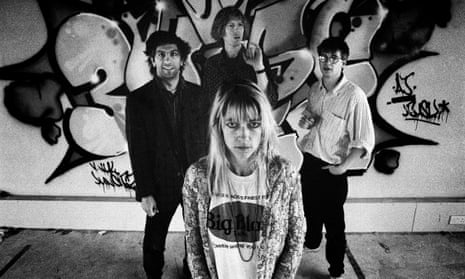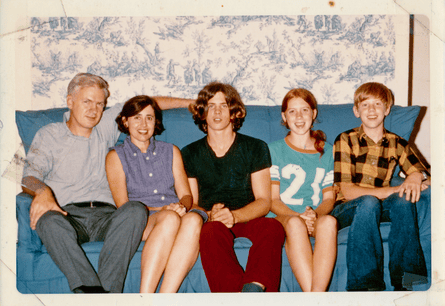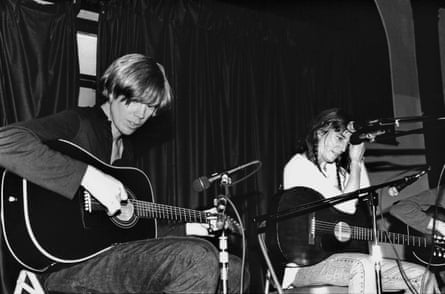Early on in Thurston Moore’s memoir, Sonic Life, he recounts a turbulent time in his teenage years when it all could have gone horribly wrong. Briefly in thrall to an older friend with criminal tendencies, he indulged in a short but spectacular bout of juvenile delinquency that included high speed car chases through the streets of his sleepy home town, Bethel, Connecticut, and culminated with them breaking into his nextdoor neighbour’s house and ransacking it. He got off lightly with a period of probation but, he writes: “My name and criminal offence appeared in the local paper and it humiliated my mother.”
Chatting with the 65-year-old Moore now over Zoom, his laid-back, thoughtful manner giving him an almost professorial air, it is hard to imagine such wild recklessness from someone who was raised in a respectable, well-off family. For a brief moment, I quip, he was punk in more ways than one.
“In some ways, I didn’t want to go there in the book,” he says, looking rueful even after all these years. “Even my editor said it was a bad look, so we softened it a bit.” With hindsight, what did he think was going on inside his head at the time? “I was looking for something, but not sure what it was,” he says, quietly. “My dad had passed away, my big brother was in the military, my sister was off in her own world and I just fell in with some no-gooders. But I also thought they were pretty punk: leather jackets, motorcycles, rule-breakers. There was a certain attraction to that but the reality is that if you go there you do get in trouble.”
Having reached retirement age, his wild days as a teenage rebel without a cause far behind him, Thurston Moore is now officially a grand old man of American indie rock – though as Sonic Life attests, his youthful enthusiasm for all things rock’n’roll remains relatively undimmed. Comprising 77 chapters that unfold over nearly 500 pages, it is an epic and minutely detailed recreation of his personal odyssey from a music-obsessed teenager in small-town Bethel to the sudden breakup of his group, Sonic Youth, in 2011.
“Initially, it was about four times longer,” he says, of the first draft he submitted to his editor. “A huge, unedited ream of stuff, page after page about every record that was significant to me in the punk and post-punk years. Basically, I just kept going and put it all in there.”
Even in its pared-down form, Sonic Life is an exhaustive insider’s account of American alternative rock music in the 1970s and 80s, with walk-on parts by everyone from Kurt Cobain to Neil Young, William Burroughs to Iggy Pop, all of whom sought out or were drawn into the orbit of Sonic Youth. For more than three decades from their formation in 1981, the group occupied a singular place in rock culture, while not ever attaining the mainstream success of the likes of REM or Nirvana. Instead, their reputation rests on being arguably the most influential and iconoclastic rock group of their time, having emerged out of the vibrant post-punk No Wave scene in downtown New York in the early 80s and somehow maintaining the sense of artful coolness that defined that era throughout their working life.

“They oozed that New York supercool that started with the Velvet Underground,” elaborates Simon Reynolds, author of Rip It Up and Start Again: Postpunk 1978-1984. “When they started out, downtown Manhattan was still an edgy, dangerous place. Going to a diner in the Lower East Side back then, you had to get a key from the staff to use the restroom because they didn’t want junkies fixing up in there. So listening to Sonic Youth albums like Sister or Daydream Nation, you could picture the band as wraith-like figures stalking the Lower East Side, wandering in a dissociative haze. Some of the songs feel like encounters with psychotic people on the streets.”
In his memoir, Moore paints a vivid picture of his early days in New York living in a “chipped and grimy” apartment in Alphabet City, where street crime and drug addiction were so rife that “every time I approached the corner of Avenue A and 13th Street I would break into a sprint to my doorway”.
Back then, the now gentrified Lower East Side was also populated by struggling artists and musicians drawn to its mean streets by affordable apartments and studio spaces, however cold, grimy and lacking in basic amenities. Once there, Moore found the creative community he had longed for since his music-obsessed adolescence in Bethel, which was less than two hours’ drive away.
“I guess I was instinctively drawn to the urban,” he elaborates, “For a time, as a young teenager, I wanted to be a hippy and hitchhike around the country, but I didn’t like the music so much. Whereas, when I was 16 in the early 1970s and I first saw a picture of Iggy Pop standing on people’s hands, his body spray-painted silver, pointing out to the skies, it was like, What is this? I needed to hear what that image sounded like.”

Having been for so long synonymous with the New York independent music scene, Moore has lived in London for the past 12 years with his partner, Eva Prinz, a book editor. The pair recently got married and moved from Stoke Newington in north-east London to somewhere down south “beyond Brixton”, though he refuses to divulge where exactly.
“We’re in the’ ‘burbs, basically,” he elaborates. “I feel much more anonymous here than in east London, which suits me fine. Eva and I are happily married and we’re in a good place, but if someone had told me 30 years ago that I’d end up living in London, I’d have thought they were crazy. You’ve got to drop your anchor somewhere, I guess, and I’ve learned to like it quite a bit. I discovered my own place here.”
These days, in between making solo albums, touring with his eponymously named band, immersing himself in London’s small but vibrant free improvisation community, and running his own record label, Ecstatic Peace, Moore lives a settled but still culturally engaged life. “The only places I frequent on a regular basis are record stores and book stores,” he tells me at one point, sounding only slightly sheepish. “I’m 65 and it’s kinda embarrassing in a way. I used to sneak away and do it because everyone else I knew was doing more grownup things, but now I just go for it.”
Sadly, Moore won’t be going for it in terms of promoting his memoir. A few weeks ago, via a post on his Instagram feed, he announced the cancellation of an imminent US book tour, citing an unspecific health problem that, “as I reach my mid-60s this year has become rather, and consistently, debilitating”. On his doctor’s advice, he will not be “flying anywhere under any circumstance” until it is sorted out. He will not be drawn on the nature of his condition.
As Sonic Life makes clear, Moore’s path in life seemed set in stone from early on. The first chapter is called Epiphany and begins in the summer of 1963, when Moore was just five and his older brother, Gene, played him a mysterious vinyl single by the Kingsmen. Louie Louie is a short, brutally repetitive blast of guitar-driven noise that kickstarted the American garage band scene of the mid to late 1960s and later shaped the punk sound of the 70s. Until Gene brought it home, the only music played in the Moore household had been his father’s classical records, but suddenly, he writes, “with Louie Louie ringing out repeatedly… the energy of our existence would change”.
All that follows in his creative life flows from that moment. At 13, he was coveting his older brother’s pristine electric guitar, strumming it furiously in secret until the strings broke. At 16, he had “a crazily beautiful sunburst Stratocaster” of his own and was playing along to the Stooges, so besotted by the photo of Iggy Pop on the cover of Raw Power that he took the album to a local hairdresser and told her: “This is what I want to look like.” In March 1976, a few months short of his 18th birthday, another epiphany occurred when he witnessed the Patti Smith Group at a venue in nearby Westport. “This is what I had been waiting for,” he writes, still sounding breathless, “Rock and roll transcendence… There was no turning back.”
Having moved to New York in 1978 entranced by the punk scene there, Moore eked out a living as a struggling musician with his first band, the Coachmen, spending what little money he made from casual jobs assisting in art galleries on records, fanzines and gigs. In 1980, he met Kim Gordon, the woman who would become his romantic and musical partner for the next 30 years. The book is inevitably a chronicle of their long relationship. They began playing music together not long after they became a couple, recruiting a passing parade of like-minded souls and calling themselves various outre names, including Red Milk and Male Bonding, before settling on Sonic Youth. In retrospect, it was nothing less than a statement of intent. When second guitarist Lee Ranaldo joined soon afterwards, the group’s signature sound began to take shape, with he and Moore using odd tunings to create often droning soundscapes over which their songs were built.

“For me, there was an ominous element to Sonic Youth’s early music,” elaborates Bobby Gillespie, lead singer of Primal Scream and, back then, drummer for the Jesus and Mary Chain, a Scottish indie band who, in the early 80s, shared a similar sensibility. “A lot of their early songs like Death Valley ‘69 were primarily about creating a mood and an atmosphere, the use of abstract tunings and textures that sounded new and exciting.”
Gordon, who hailed from California, had initially gravitated to New York to pursue an art career, establishing friendships with downtown artists such as Mike Kelley and Dan Graham. In great part because of her art world savvy and myriad connections, Sonic Youth, more than any other band since the Velvet Underground in the late 60s, managed to somehow combine conceptual art ideas and street level credibility. They took their initial energy from the underground American hardcore punk scene and their visual aesthetic from artists as diverse as Gerhard Richter, whose painting Kerze (Candle) was used on the cover of their 1988 album, Daydream Nation, and Raymond Pettibon, whose work graced the cover of 1990’s Goo.
I put it to Moore that there was always a knowing, carefully curated element to their image that was both arty and edgy. “Well, when we came together, we wanted to be everything, because our ears and eyes were everywhere,” he answers. “The question was, how to we unify all this? And our answer was, let’s just do what we do and see what happens. Before punk, you didn’t feel like you could do that.”
Moore meticulously maps out the group’s long trajectory across three decades and 16 albums, during which they went from music press darlings to the brink of mainstream success. Daydream Nation is now widely regarded as their greatest album and a major influence on the generation that followed, most notably Nirvana. Along the way, they released Into the Groove(y), a cover of the Madonna song under the name Ciccone Youth, collaborated with Public Enemy rapper Chuck D on the single Kool Thing, and were lauded by Neil Young, who invited them to tour with him in 1991. Always slightly ahead of the game, they also hired the young and unknown Spike Jonze to direct the video for their song 100%, and this particular brand of downtown New York cool somehow endured even as they signed a major deal with Geffen Records in 1990.
Throughout the book, the musical reportage is seasoned by biographical passages that give us a glimpse of Moore’s inner life beyond music, including his formative but fraught friendship with a flamboyant young gay man, Harold Paris, who took umbrage at what he saw as Moore’s pretensions when he began hanging out with the downtown music and art crowd.
“I think Harold was OK with the band, but he just sort of bristled at the fact that he wasn’t along for the ride any more,” says Moore, “and that I was buying into this real downtown New York sarkiness, which was such an affectation. I see clips of myself now and I think, God, I would punch myself in the face. So, I get it, but there was also an unrequited love there. He admitted as much later but, back then, I didn’t really want to talk about it in my own frightened hetero way.”
At times, I say, it felt to me like there was another more deeply personal memoir buried somewhere in this bigger panoramic account of his musical life. “I felt I could have expanded that side a lot more, actually,” he replies. “I mean Just Kids, Patti Smith’s memoir, is essentially about her relationship with Robert Mapplethorpe. That’s the reason she wrote it and what makes it tick, that very simple one-on-one relationship. At one point, I did step back and think, that’s what I should be writing about, but people want to know about the other stuff, the band, the scene, so I put it all in there and it was huge.”
In order to have taken that more intimate approach, though, he would have had to recount in detail the messy fracturing of his longterm relationship with Gordon, which happened in 2011 after 30 years as rock’s coolest couple, 27 of them as husband and wife. The announcement of their separation sent shock waves of disappointment and disbelief through an indie-rock culture in which they had acquired a revered status. The journalist Dorian Lynskey memorably once described their relationship as seeming “as solid as their music was tempestuous: Paul Newman and Joanne Woodward with feedback”.
While Gordon poured her hurt and simmering sense of betrayal into her 2015 memoir, Girl in a Band, Moore has remained tight-lipped on the subject. In Sonic Life, he maintains that silence to a great degree, save for the admission that they attended marriage counselling “to no avail”, concentrating instead on the flowering of his overlapping romance with Prinz. When I mention this and recall how much their fans had invested in Gordon and him as a kind of ideal modern creative couple, he nods but looks uncomfortable.
“I guess so and understand that to a degree. I get it that there was a lot of public emotion invested in what was perceived, but I really had nothing to do with that and it doesn’t really define anything as to what happened creatively.” He pauses for a moment, before responding pointedly: “Usually when people ask me stuff like this, I’m like, ‘Do I know you?’ Or, ‘Why does that even interest you so much?’ I had certainly no interest in writing about it or indeed feel like it’s a topic worth sharing apart from with family or intimates. Certainly not publicly, but of course it was difficult. Everyone who has a fissure in their relationship, no matter how long or short, it’s just no fun for anyone.”
In many ways, Sonic Life is an elegy not just for Sonic Youth, but for lost time when punk and post-punk energised a generation and reverberated through the music that his group and others made in their wake. “Punk was limited but it could not go away,” Moore says, “because no one wanted to see it dissipate. To me it just made it feel like everything was possible.”
The sense of liberating possibility and shared secret knowledge that underground rock culture once created seems impossibly distant in our globally connected age of information overload. Moore nods in agreement but remains an eternal – and youthful sounding – optimist. “There has been a paradigm shift in how we access stuff and rock music has been commodified to a degree that there is hardly any shock value there any more,” he says, “but there’s always incredible music being made, from avant-garde jazz and rock to punk. Everybody’s in the pool, swimming around. That’s always going to be happening. Nothing is dying.”

Comments (…)
Sign in or create your Guardian account to join the discussion